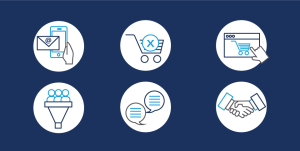One of the most important marketing channels to build, activate, and automate is email marketing. While many ecommerce brands primarily deploy email campaigns with the goal of driving sales, the highest-performing online shops place emphasis on automated email flows.
In this article, we’ll explore how drip email campaigns work, when they should be implemented, and which ones you should focus on first.
How Automated Marketing Emails Work
Automated email campaigns, also known as drip campaigns, are templated emails often designed to work in a series. They are triggered by any number of conditions. When recipients perform an action or a condition is met, your email marketing software automatically sends a specific email. Examples of those conditions include:
- Page abandonment
- Cart abandonment
- Visits to specific pages
- Placed order
- Time between events

Additionally, you can funnel different subscribers into specific drip campaigns using filters such as:
-
Location
-
Customer segment
-
Previous email activity and engagement
-
Purchase history
The brilliance behind automated email campaigns is that with them you can personalize your messaging based on the different stages of your customer’s research, buying, or post-purchase journey without having to manually send every email.
When to Implement Drip Email Campaigns
Effective email drips almost act like a personal concierge to your subscribers. They remind customers about your store at moments when the recipient is more inclined to:
-
Engage with your brand (even if it’s just to read the email)
-
Make a purchase (whether it’s a first-time purchase or a repeat order)
-
Research your company or products (before they even reach out to your customer service or sales teams)
Let’s dive into specific email automation strategies that combine all of the different elements above: triggers, filters, and scheduling.
Automated Email Campaigns Your Store Should Create
To execute a comprehensive email automation strategy, here are six distinct email campaigns your store should automate.
-
Browse abandonment emails: These emails are triggered when a shopper visits a product page but doesn’t add the item to their cart or place an order, and then they leave your website. Within a few hours, send an email that educates the customer about the item(s) they viewed and provide them with any other information that might positively influence their purchase decision. Don’t be pushy, just informative.
-
Cart abandonment emails: Among many ecommerce businesses, this is the most effective automated email. Send shoppers an email within a few hours after they’ve browsed your site and added products to their cart, but failed to complete the purchase. Sometimes, customers are in a rush and can’t complete an order when they first visit your site. This email campaign makes it easy for them to pick up where they left off and expedite the checkout experience.
-
Post-purchase emails: After a customer places an order, brands are expected to send transactional emails, such as an order confirmation and shipping updates, immediately after each event. To take your email marketing a step further, you can include informational emails that cover frequently asked questions, cross-sell and upsell campaigns to increase customer lifetime value, and even product review requests. Non-transactional post-purchase emails can be timed several days, several weeks, or several months after order delivery.
-
Lead nurturing emails: Early in the funnel, you may capture interest from visitors who interacted with an ad, visited one of your landing pages for the first time, or downloaded marketing materials. Keep in mind that, at this stage, shoppers might not be ready to make a purchase. In these situations, provide them with an informational series of emails that highlight your unique selling propositions while gently encouraging them to revisit your website to shop.
-
Post-chat emails: Integrate your email marketing with all other aspects of the customer experience. After guests wrap up a chat bot session, for example, send them an email along with related knowledge base articles in case those help answer any follow-up questions. Brands that are proactive in addressing customer curiosities and concerns build loyalty and trust which, in turn, lead to higher sales and more positive word of mouth.
-
Winback emails: One of the least common — but most effective — drip emails is the winback series. Here, you can find unique ways to prompt email opens among subscribers who haven’t opened your email in a while. Another filter to consider is time between purchases. You might want to prompt previous shoppers to check out your latest offerings if they haven’t placed an order in several months.
As you apply different rules and settings to your new automated email campaigns, you’ll want to check the flow between emails that are part of a series. You can share different bits of information at strategic times while also testing a variety of copy, images, and offers to see which ones resonate with the customer.
























